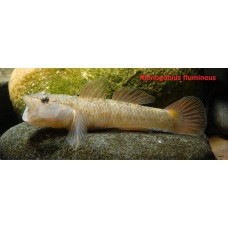Fish that live near the bottom (podkamenchiki, ruffe, Siberian char, flounder and many others) and feed mainly on benthos - mosquito larvae, small bristle worms and other organisms living on the surface and in the depth of the body of water. They are poor swimmers, many have flattened body, patronizing coloration to match the color of the ground, suction cups, which they use to suck on rocks, well-developed pectoral fins, which they rely on the ground, some of them turn into organs of movement (sea devil, mudskipper, Trigla).
Groundfish, also demersal fish, are fish that spend most of their life cycle on the bottom or in close proximity to the bottom (benthic fish). They occur both in the coastal areas of the continental shelf and in the open ocean along the continental margin of the continental slope. They are generally absent in the abyssal and ultraabyssal zone and on the abyssal plain. They occupy the seabed covered with silt, sand, gravel, or boulders. However, many groundfish have pelagic eggs and larvae.
In the deepwater zone, groundfish are quite abundant and active compared to bathypelagic fish. Long-tailed fish, bitites, giltheads, shovelnose sturgeons, and pinnipeds are common here.
Bottom fish have well-developed organs and muscles. In these parameters, they are closer to mesopelagic fish than to the inhabitants of the bathypelagic. They are more diverse. They usually lack photophores. Eyes and swim bladder may be well developed or atrophied. They vary greatly in size, often occur large specimens over 1 m long.
Many demersal fish have a long and narrow body, similar to eels. This may be due to the length of the lateral line, which captures low-frequency sound waves, while some fish use their muscles to make similar sounds, attracting sexual partners. The sense of smell also plays an important role, judging by how quickly they are caught by live bait. The diet of demersal fish is based on benthic invertebrates and carrion. They find food mainly through their lateral line, sense of smell and sense of touch.
Demersal fish can be divided into strictly benthic and bentopelagic, having negative and neutral buoyancy, respectively. Benthic fish are in constant contact with the bottom. They either lie in ambush waiting for prey or actively move in search of food. Many groundfish, like flatfish and rays, have a body shape adapted to life on the bottom, patronizing coloration, and are able to burrow into the ground. Groundfish are fished with bottom fishing gear (snorkelers, trawls, hook and line tackle, fixed nets, etc.). Bentopelagic fish are caught with pelagic fishing gear.
Bottom fish can be divided into two main types: pure bottom (benthic) and bentopelagic, which rise above the bottom and swim in the water column. Bentopelagic fish have neutral buoyancy that allows them to swim effortlessly, while bottom fish have denser bodies and negative buoyancy that keeps them on the bottom without expending energy. Bentopelagic fish outnumber purely bottom-dwelling fish. In addition to the flattened body shape, an adaptive structural feature of many groundfish is the lower mouth, which allows them to feed from the ground. Sand sucked in with food is usually erupted through the gill slits. However, starfish have an upper mouth and upward pointing eyes as they hunt prey floating in the water column.
Beyond the edge of the continental shelf, the abyssal depths gradually begin. Here is the boundary between the coastal, rather shallow benthic habitats and the deep-water benthal. Coastal groundfish live in shallow estuaries and bays and further on the bottom of the continental shelf. Deep-sea groundfish live beyond its edge, mostly on the continental slope and at the continental foothill, which transitions to the abyssal plain. The area of this boundary area is about 28 % of the area of the World Ocean. In addition, deep-sea bottom fishes are found near submarine pinnacles and islands. The term "bathydemersal" sometimes refers to deep-sea groundfish that live on or near the bottom at depths greater than 200 m. Epibenthic organisms living on the surface of the ground are called epibenthic.
Bottom fish
Tags: bottom fish



